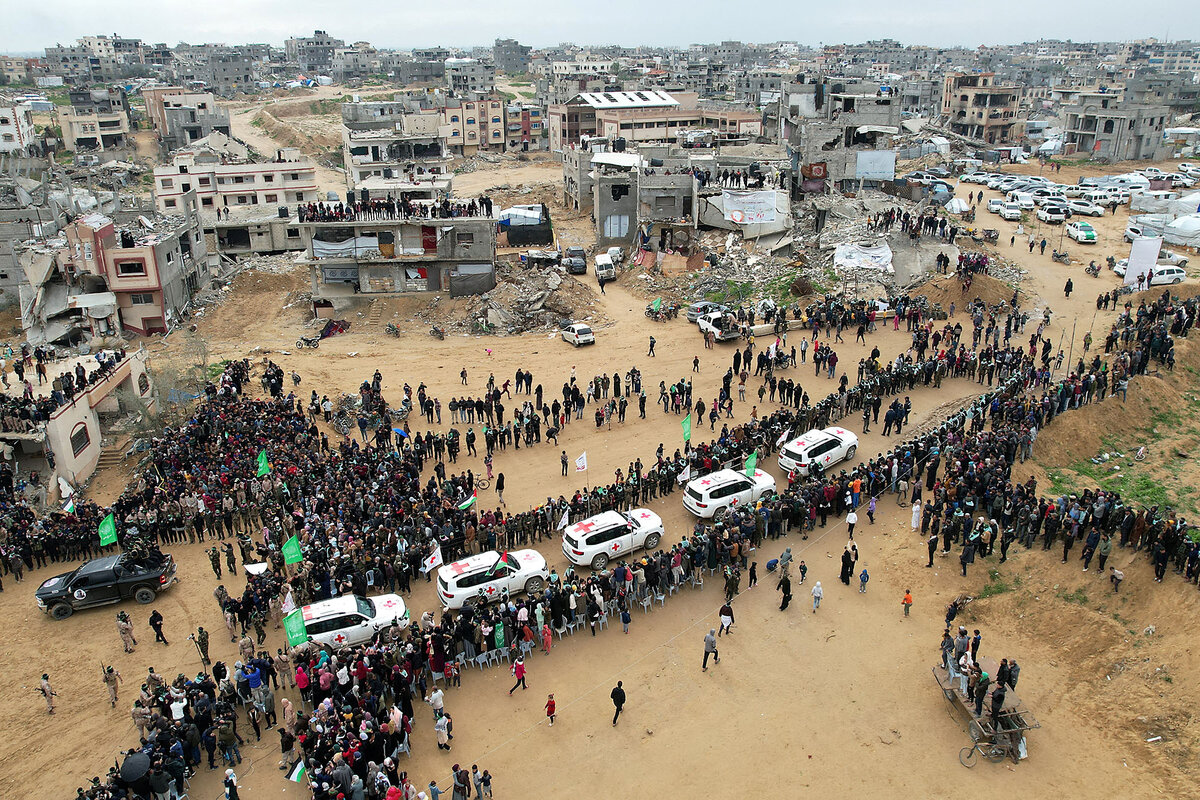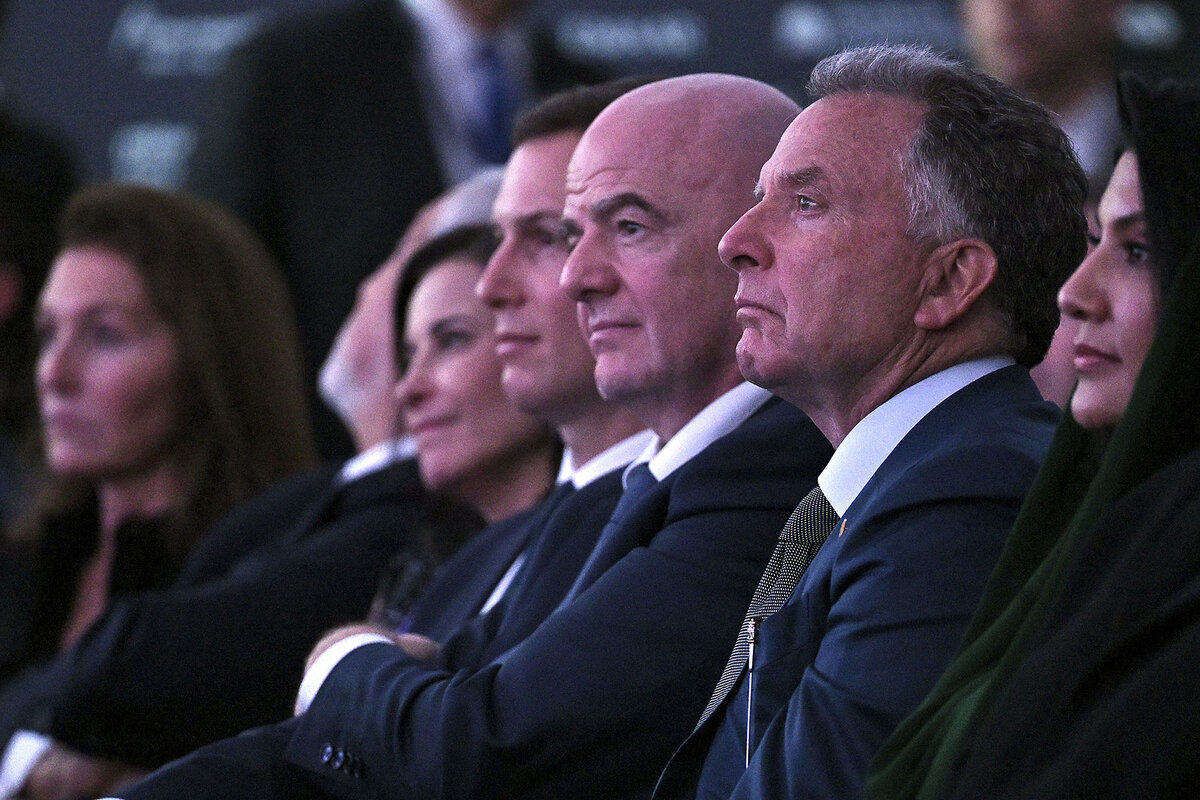What’s next for the Gaza ceasefire? Netanyahu pressed from all sides.
Loading...
| Tel Aviv, Israel
Phase 2 of the ceasefire with Hamas in Gaza is confronting Prime Minister Benjamin Netanyahu with an impossible puzzle.
Under immense pressure from U.S. President Donald Trump, the Israeli leader committed to the second phase of a broader hostages-for-prisoners deal, but it’s one he’s reportedly loath to complete.
That’s because its final stage calls for Israel to end the war in Gaza by withdrawing all its troops – but with no guarantee that Hamas, which inflicted the most devastating attack in Israel’s history, won’t remain in power.
Why We Wrote This
A story focused onBenjamin Netanyahu is in a bind over Gaza, and peace is at stake. His hard-right allies want a resumption of the war. An emotional Israeli public wants more hostages released. The United States wants the ceasefire with Hamas to proceed.
Mr. Netanyahu is also facing pressure from much of the Israeli public, which is desperate to see the return of more hostages, some of whom have returned from captivity emaciated and with tales of being chained and beaten.
At the same time, the far-right flank in his coalition is agitating to return to war to finally crush Hamas and threatening to topple the government if it does not.
The lack of government enthusiasm for the second stage points to the discrepancy between what each side wanted from the deal, says Lazar Berman, diplomatic correspondent for The Times of Israel.
“The government took this deal because of the first stage. It wanted to get as many hostages out as possible without committing to ending the war,” he says. “And Hamas wanted the deal because of the second stage, which is ending the war, and it was willing to give up a lot of hostages.”
Four coffins
Hamas has been betting that pressure to continue the deal would mount once Israelis saw their people returning. Indeed, Israel has been awash in emotional scenes of hostages seized in the Oct. 7, 2023, attack reunited with their families – three or four per week – since the truce began in late January.
Until now, all had been living. But Thursday, in one of Israel’s most grief-soaked days of the war, Hamas returned four coffins, three of which it said contained the bodies of Shiri Bibas and her two redheaded young sons.
Their abduction from Kibbutz Nir Oz, videotaped by the kidnappers themselves, came to symbolize the cruelty of that day.
The fourth deceased hostage returned Thursday was the Bibas family’s neighbor, Oded Lifschitz, a peace activist and retired journalist captured at the age of 83. Under overcast skies, flag-waving Israelis paid their respects as vehicles carrying the four coffins transported them from Gaza to a Tel Aviv forensics lab for positive identification. Early Friday it was announced that the Bibas boys’ identity had been confirmed but that the other body did not match Shiri Bibas’ DNA.
The sad day was a reminder for the public, some 70% of whom want to see the ceasefire deal completed, that the remaining hostages are at grave risk, adding to the pressure on the government to move forward.
TV coverage of the return Thursday included heavy criticism of Mr. Netanyahu, a political survivor and Israel’s longest-serving prime minister, who is aware of the backlash should the deal unravel.
Still, “The Israeli government is trying all sorts of ways to quietly buy time and not move to the second phase,” says Mr. Berman.
American pressure
Despite a recent ultimatum by President Trump to Hamas to release all hostages by last Saturday, the U.S. administration’s message has now shifted. Pressure to move forward with the second phase is coming in a united message from two key figures, Secretary of State Marco Rubio and special Middle East envoy Steve Witkoff.
“We are hopeful we will be as successful in Phase 2 as we were in Phase 1,” Mr. Witkoff told a pro-Israel crowd in Miami attending a memorial event for the almost 400 young Israelis killed at a music festival during the Hamas attack, adding that he did not plan on leaving anyone behind. He also told Fox News that “Phase 2 is absolutely going to begin,” making sure to emphasize he had calls with Mr. Netanyahu and Egyptian and Qatari officials mediating negotiations.
Israeli prime ministers typically are wary of crossing U.S. presidents early in their term, notes Ehud Eiran, a professor of international relations at University of Haifa, but this is especially true of Mr. Trump, known to be “willing to break all the rules.”
Yet such U.S. pressure can be helpful for Mr. Netanyahu, as it has been in the past, when trying to wrangle those far-right coalition partners intent on a return to war to complete Hamas’ ouster.
Meanwhile, the Arab League, in response to Mr. Trump’s proposal to empty and rebuild Gaza, is working on its own reconstruction plan under a technocratic government without Hamas, whose leadership possibly would be sent into exile. One question is whether Hamas would seek to linger as a shadow military movement.
According to Ofer Guterman, a senior researcher at the Institute for National Security Studies, a Tel Aviv think tank, one scenario would be to stretch out Phase 1 longer, to buy time on the political side to work out agreements with the Arab states and the United States.
For now, the pressure only grows in Israel to see every hostage returned. Returning hostages, who have reported sightings of others still alive in Gaza, are giving the families of the remaining hostages new hope.
Yair Horn, a hostage who returned last Saturday, but whose brother is still captive, said in a video, “I tell you there is no time left.”
“Everyone asks me what I need, and I say, just one thing: Bring back my brother,” he says, pausing to wipe away tears. “And all the hostages.”








